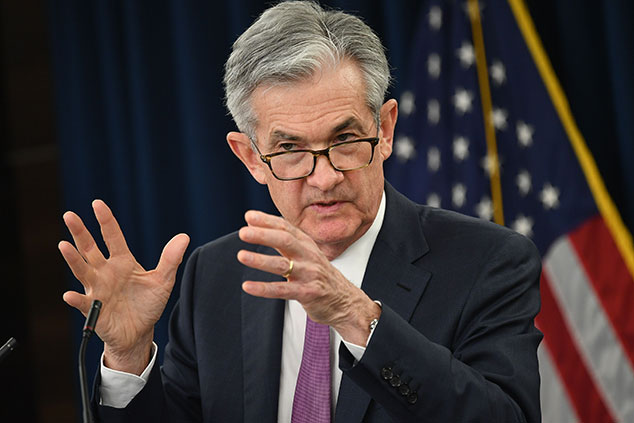
This article is taken from our FREE daily investment email Money Morning.
Every day, MoneyWeek’s executive editor John Stepek and guest contributors explain how current economic and political developments are affecting the markets and your wealth, and give you pointers on how you can profit.
It’s starting to look ugly out there. Markets across the globe suffered a nasty slide yesterday.
“Well, no wonder”, you’re saying. “Look at the political havoc. China and the US don’t know whether they’re coming or going, and here in the UK, Theresa May refuses to go fast enough. I mean, markets hate that kind of uncertainty, right?”
They probably should. And they do to an extent. There’s no doubt that the escalating global trade conflict is rattling the market in specific areas.
Yet this is still mostly about central banks.
Jerome Powell just isn’t worried enough yet for the market’s liking
You probably didn’t even notice one of this week’s most consequential stockmarket events. There was way too much other exciting political stuff to talk about.
On Wednesday, the Federal Reserve, America’s central bank, issued the minutes from its latest regular meeting. Now, bear in mind that the Fed did a massive U-turn earlier this year (or what was perceived as one by markets). The Fed went from raising interest rates, with plans for more rises, to stopping outright.
The market surged. If you want to pin the epic rebound we’ve seen in 2019 on anything, then it’s clearly the result of Fed policy easing off – it’s certainly not down to any other market-friendly event.
But here’s the problem: markets were already expecting the Fed to cut interest rates before the end of this year (and they still are). And yet, while the Fed might have come to a halt earlier this year, it’s nowhere near intellectually ready to move back into rate-slashing mode, let alone money printing mode.
The Fed said that it’s not worried about the slowdown in inflation – it reckons this will pass. In other words, it’s still relatively upbeat on prospects for the economy. In other words, this is not a Fed that is walking on eggshells.
It’s in no rush to raise interest rates, of course. But the problem is, markets want reassurance. They are looking for a central banker who will mop the collective fevered brow, à la Ben Bernanke or Janet Yellen. They don’t want someone who still tries to act as though markets are not the uppermost thing on his mind.
Now, to be fair, the latest meeting was held before the most recent escalation of trade tensions. The tone would probably have been a lot less punchy otherwise. But the sense remains that this is not a Fed that’s primed to spring to the rescue. That’s a reminder to the market that they don’t really know exactly where the “Powell put” is as yet.
Markets still believe that the Fed will have to cut interest rates this year. But they’re also starting to believe that it might take a big slide in asset prices before that happens.
The fear of deflation is back yet again
Meanwhile, on the trade front, investors are also recognising that trade tensions have led to stockpiling – of everything from oil to microchips. That recognition is what’s driven the collapse in microchip manufacturers (even if trade talks are reignited, then there’s already too much inventory hanging about).
It’s also probably the major factor behind the tumble in the oil price we saw yesterday. Data issued yesterday by the US Energy Information Administration revealed that US crude oil inventories have risen to their highest level in two years.
So on the one hand, we have a trade situation that is starting to come to the market’s attention. On the other, we have a Fed that isn’t providing enough reassurance to convince investors that they might as well buy the dip.
Hence, we’ve got the deflation bells ringing again. Long-term interest rates (ie, US Treasury yields) are falling (despite all the talk of China selling government bonds) and investors are starting to price in a recession again.
What comes next? If markets get rattled enough, we’re probably looking at dovish chatter from the Fed and perhaps conciliatory talk from Donald Trump (he’s already made a bit of an approach to China, suggesting that Huawei could be part of any deal, notes the FT).
It’s rather up in the air right now though. What would make me feel more relaxed about markets? A weaker dollar. What would worry me? Much more dollar strength. A strong dollar puts pressure on almost every part of the market for reasons we’ve discussed before.
We’ll have to wait and see. On that front though, here’s an event you won’t want to miss – on 11 June at 1pm, my colleague Dominic Frisby (who also writes our new Currency Corner column) and I will be holding a live webinar with currency specialist Alex Edwards of currency broker OFX.
We’ll be discussing everything from the state of global trade to the effect of the current political upheaval on sterling and other major world currencies, and we’ll also be taking questions during the webinar.
So register to watch it live here (it’s at lunchtime, so you can enjoy it with a sandwich and a nice cup of tea). It’s totally free, so if you can’t make it on the day, you can always watch the recording later. Just make sure you register.